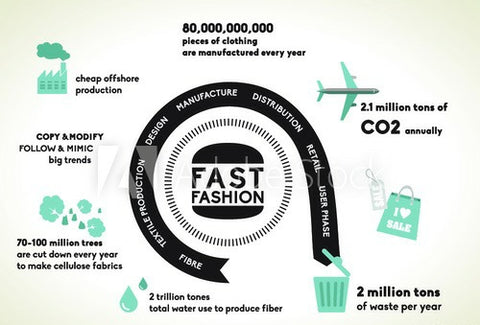
Fast Fashion – The Villain in our Closets
Villains don’t always exist in movies. Sometimes, they live in our closets.
The name of this particular villain is ‘Fast Fashion’.
Fast fashion brands have built an entire industry by introducing endless trends every year and convincing customers to buy substandard clothes at cheap prices so that they can continue racking up profits with each new purchase.
We didn’t take any names, but a few popped up in your head already, didn’t they?
Fast Fashion, Grave Repercussions
Fast Fashion has had such deep-reaching psychological impacts that consumers now experience some sort of Cinderella-syndrome where if you wear an outfit a couple of times, it’s likely that you’ll never wear it again because society tells you that repeating clothes is an unforgivable sin.
Trying to keep up with these ever-changing norms and fashion trends can be financially catastrophic and emotionally overwhelming.
So, why has this happened?
For starters, owing to the extremely inferior fabric quality used by such brands, our clothes look old and faded after only a few washes. So, we have no choice but to discard them. Second, as fashion trends keep changing at lightning-quick speed, we feel pressured to keep up with them. Earlier, there used to be 4 major fashion “seasons” which coincided with the actual seasons of the year. Sounds perfectly logical.
But now, fashion trends are introduced like Oreo flavours - there’s just too many of them. Social media’s “Outfit of the Day” culture has led us to consume fashion in a way that is transient and performative. This has created an impulse to shop more and more often, leading us to buy from fast fashion brands which offer the latest trends at such absurdly low prices that we find ourselves picking up an item in every colour.
But have we ever stopped to consider how these brands manage to keep their prices so low?
This is when we step into the seedy underbelly of this industry. Fast fashion brands are wildly infamous for exploiting labourers in developing countries like India, China, and Bangladesh. While we may be paying a pretty penny for their products, not even a small fraction makes its way into the hands of its makers. To put things in perspective, if an item costs us $20, then its maker is paid something in the ballpark of 20 cents.

Fast fashion brands are notorious for indulging in sweatshop labour where the “employees” (a loosely used term in this case) are overworked, underpaid, often underage, and subjected to deadly, slave-like working conditions. These workers are paid pennies on the dollar in the name of a “minimum wage” while their employers are skipping steps as they climb the ladder of the Forbes Rich List.
To make matters worse, fast fashion is destroying our planet. Companies seem to only care about profits while they continue to dump toxic dispose into our rivers and overflood landfills with non-biodegradable waste. About 8000 different chemicals are used in the production of fast fashion, many of which are scientifically known to cause cancer and other such fatal diseases. And fashion labels are counting on us to remain blissfully unaware about this because the longer we do, the more zeroes are added to their net worth.

And sure, there are a handful of brands that are incorporating some sustainable practices in their production process. But that’s too little, too late. We’re going through a climate and a health crisis - we can’t celebrate a brand just because they decided to introduce a microscopic sustainable collection to compensate for the millions of synthetic items that they produce each day.
Slow Fashion, Low Impact
However, it’s not all doom and gloom. There are many brands, much like Folk, who are extremely conscious of the environmental and social impact of their production. We strive to bring about real change in the industry by using eco-friendly materials, sustainable manufacturing techniques, ethical production practices and streamlined textile supply chains.
Right from the outset, we design all our products to be used repeatedly for years by using durable and high-quality materials. While many brands focus on the latest trends and new colour palettes, at Folk, we identify the most neutral colours, and then create classic silhouettes that remain timeless. We lay emphasis on how our customer will use a particular product, and how we can encourage them to use it for as long as possible through upcycling and recycling.

But having said that, until the fast fashion behemoths truly incorporate sustainable and moral production efforts on a large scale, we still have a long way to go. And this can only be realised through conscious consumption. After years of putting convenience and cost before everything else, it’s time we started investing value into each item that we buy. We need to consume less and consume it more consciously from brands who are forthcoming about their production process.
As consumers, we need to normalize owning fewer garments and using them for longer. Because even though many brands like ours are committed to being sustainable, experts say that this is unlikely to make a noticeable difference if consumer behaviour doesn’t change for the better and if the industry continues overproducing. Thus, conscious brands and consumers alike need to become allies in this uphill battle towards a more sustainable fashion.

Consumers have the power to demand real, effective sustainability in their fashion, and the key to this is change in consumer buying behaviour. The goal is to cause a simultaneous shift in production and consumption practices to pave the way for a better tomorrow.
Because, at the end of the day, Sustainable Fashion starts with You.

